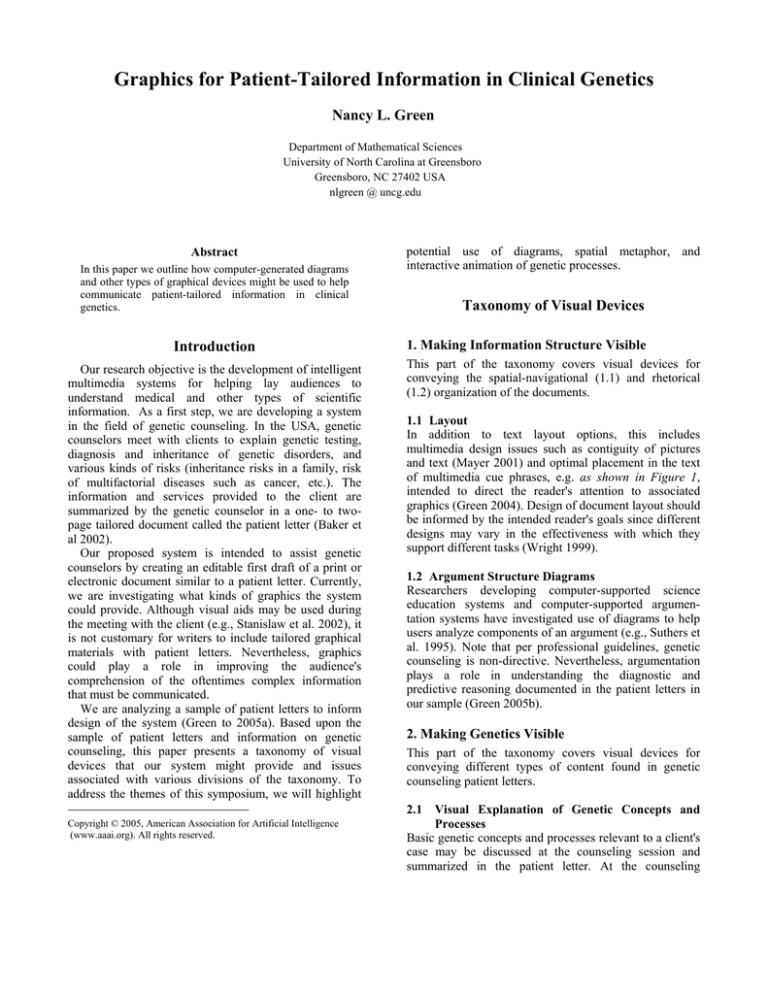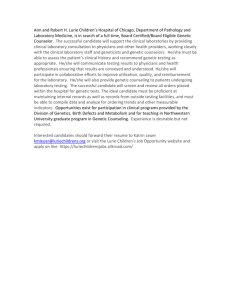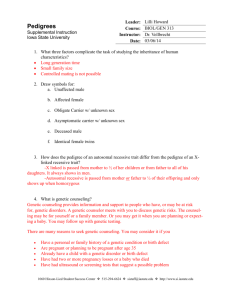
Graphics for Patient-Tailored Information in Clinical Genetics
Nancy L. Green
Department of Mathematical Sciences
University of North Carolina at Greensboro
Greensboro, NC 27402 USA
nlgreen @ uncg.edu
Abstract
In this paper we outline how computer-generated diagrams
and other types of graphical devices might be used to help
communicate patient-tailored information in clinical
genetics.
Introduction
Our research objective is the development of intelligent
multimedia systems for helping lay audiences to
understand medical and other types of scientific
information. As a first step, we are developing a system
in the field of genetic counseling. In the USA, genetic
counselors meet with clients to explain genetic testing,
diagnosis and inheritance of genetic disorders, and
various kinds of risks (inheritance risks in a family, risk
of multifactorial diseases such as cancer, etc.). The
information and services provided to the client are
summarized by the genetic counselor in a one- to twopage tailored document called the patient letter (Baker et
al 2002).
Our proposed system is intended to assist genetic
counselors by creating an editable first draft of a print or
electronic document similar to a patient letter. Currently,
we are investigating what kinds of graphics the system
could provide. Although visual aids may be used during
the meeting with the client (e.g., Stanislaw et al. 2002), it
is not customary for writers to include tailored graphical
materials with patient letters. Nevertheless, graphics
could play a role in improving the audience's
comprehension of the oftentimes complex information
that must be communicated.
We are analyzing a sample of patient letters to inform
design of the system (Green to 2005a). Based upon the
sample of patient letters and information on genetic
counseling, this paper presents a taxonomy of visual
devices that our system might provide and issues
associated with various divisions of the taxonomy. To
address the themes of this symposium, we will highlight
Copyright © 2005, American Association for Artificial Intelligence
(www.aaai.org). All rights reserved.
potential use of diagrams, spatial metaphor, and
interactive animation of genetic processes.
Taxonomy of Visual Devices
1. Making Information Structure Visible
This part of the taxonomy covers visual devices for
conveying the spatial-navigational (1.1) and rhetorical
(1.2) organization of the documents.
1.1 Layout
In addition to text layout options, this includes
multimedia design issues such as contiguity of pictures
and text (Mayer 2001) and optimal placement in the text
of multimedia cue phrases, e.g. as shown in Figure 1,
intended to direct the reader's attention to associated
graphics (Green 2004). Design of document layout should
be informed by the intended reader's goals since different
designs may vary in the effectiveness with which they
support different tasks (Wright 1999).
1.2 Argument Structure Diagrams
Researchers developing computer-supported science
education systems and computer-supported argumentation systems have investigated use of diagrams to help
users analyze components of an argument (e.g., Suthers et
al. 1995). Note that per professional guidelines, genetic
counseling is non-directive. Nevertheless, argumentation
plays a role in understanding the diagnostic and
predictive reasoning documented in the patient letters in
our sample (Green 2005b).
2. Making Genetics Visible
This part of the taxonomy covers visual devices for
conveying different types of content found in genetic
counseling patient letters.
2.1 Visual Explanation of Genetic Concepts and
Processes
Basic genetic concepts and processes relevant to a client's
case may be discussed at the counseling session and
summarized in the patient letter. At the counseling
session, the counselor may make use of visual aids (e.g.
Stanislaw et al. 2002). Typical types of aids include
pedigree diagrams (a standard notation for drawing
family trees, which may be annotated with medical
information about family members and with risk
information), diagrams of normal compared to abnormal
chromosomes and genes, and static diagrams of
inheritance processes.
Static diagrams of inheritance processes may be less
effective than interactive animated diagrams due to the
probabilistic nature of inheritance. For example, consider
single-gene recessive inheritance. Suppose each parent is
a carrier of a certain mutation, i.e., each parent carries one
normal and one abnormal allele of this gene. Each parent
contributes one allele of the pair to his or her child.
However, a parent has no control over which of his or her
alleles is inherited by the child. If the child inherits a
mutated allele from both parents, i.e., if the child inherits
two mutated alleles, the child will be affected with the
corresponding genetic disorder. The chance that a child
will inherit two mutated alleles in this case is 25%, and is
the same for each child that these two parents have
together.
Aside from the problem of communicating the exact
numeric risk (see 2.3), a static diagram cannot easily
convey the non-deterministic outcome of this process. A
typical approach is to provide a pedigree diagram
showing the parents and four potential offspring, one
offspring for each possible combination of inherited
alleles. However, this type of presentation is subject to
misinterpretations such as the fallacy of non-independent
events (i.e., that if the client has had three children so far
and none are affected then the next child will be affected).
In contrast, we propose to provide a user-controlled
animation that randomly chooses which allele is shown to
be inherited from each parent. After running the
animation several times the user could get a sense of the
variability in possible outcomes.
Another issue is communication about causality. The
letters often describe a chain of causally related events,
either occurring in the past or projected to occur in the
future. For example, a mutation of the gene GJB2 causes
the abnormal production of protein controlling chemical
equilibrium of the inner ear which results in hearing loss.
However, it may be challenging for a reader to construct a
corresponding mental model due to the order of
presentation in the text of elements of the chain. In some
cases, part of the chain may be described in causal order
while other parts may be described in reverse of causal
order (Green 2005a). While controlling presentation order
in the text is one strategy for helping the reader to
construct a mental model of the causal chain, an alternate,
graphical, strategy is to depict the causal chain using the
metaphor of a path. Such a metaphor is implicit in the
causal network diagrams used by artificial intelligence
researchers to model causal reasoning (e.g. Korb and
Nicholson 2004). (Note we are not proposing to adopt the
causal network notation of AI
communication with lay audiences.)
researchers
for
2.2 Visual Presentation of Epidemiological Data
Tables and information graphics such as bar charts and
pie charts may be used at the counseling session to
present epidemiological data (e.g. Stanislaw et al. 2002).
There is a considerable body of psychology research on
graph interpretation and the relationship of graph design
to task performance. While scientists and clinicians are
trained in table and graph interpretation, using these
media in documents for patient communication without
providing assistance with interpretation may be
problematic.
2.3 Visual Communication of Risk
This section focuses on risk-specific communication
issues for lay audiences. Lipkus and Hollands (1999)
survey visual techniques that have been used in the past
for communication of risk such as risk ladders,
histograms, pie charts, and depictions of bowls of
marbles. Pointing out the need to consider task in design
of effective graphics, they distinguish the following risk
communication tasks: communication of risk magnitude,
communication of relative risk (e.g. the risk of breast
cancer for those with a mutation of the BRCA1 gene
compared to those with no mutation), communication of
cumulative risk over time, and communication of
interaction among risk factors (e.g. how the risk of cancer
is influenced by both genetic and environmental factors).
Lipkus and Hollands also list seven criteria from
(Weinstein and Sandman 1993) for evaluating the
effectiveness of visual displays for risk communication
including the following: whether the audience
understands the information, whether the audience finds
the presentation format easy to use, and whether the
audience has an adverse emotional reaction to the
presentation format. To give an example of the latter
issue, for types of risk outcomes that are highly feared a
more vivid presentation is likely to be more disturbing to
the audience than one conveying the same numeric
information in a less vivid format. This point led us to
reconsider the advisability of providing an animation
using human figures to explain the process involved in
development of breast cancer in individuals carrying the
BRCA1 mutation.
Acknowledgments
This material is based upon work supported by the
National Science Foundation under Career Grant No.
0132821.
References
Baker, D.L., Eash,T., Schuette, J.L., and Uhlmann, W.R.
2002. Guidelines for Writing Letters to Patients. Journal
of Genetic Counseling 11(5): 399-418.
Green, N. 2004. Using HCI Experiments to Validate
Intelligent Multimedia Cue Generation. In Proc. 17th Int.
Florida AI Research Society Conf (FLAIRS-2004), 899904.
Green, N. 2005a. A Bayesian Network Coding Scheme
for Annotating Biomedical Information Presented to
Genetic Counseling Clients. J Biomedical Informatics.
Forthcoming.
Green, N. 2005b. A Study of Argumentation in a
Probabilistic Causal Humanistic Domain: Genetic
Counseling. Int. J Intelligent Systems. Forthcoming.
Korb, K., and Nicholson, A. 2004. Bayesian Artificial
Intelligence. Boca Raton: Chapman & Hall/CRC Press.
Lipkus, I.M., and Hollands, J.G. 1999. The Visual
Communication of Risk. Journal of the National Cancer
Institute Mongraphs No. 25: 149-163.
Mayer, R.E. 2001. Multimedia Learning. Cambridge,
England: Cambridge U. Press.
Stanislaw, C.L. et al. 2002. Genetic Counseling Aids. 4th
ed. Greenwood, SC: Greenwood Genetic Center.
Suthers, D., Weiner, A., Connelly, J., and Paolucci, M.
1995. Belvedere: Engaging Students in Critical
Discussion of Science and Public Policy Issues. AI-Ed 95,
7th World Conf on AI in Education, 266-273.
Weinstein, N.D., and Sandman, P.M. 1993. Some criteria
for evaluating risk messages. Risk Analysis, 13:103-14.
Wright, P. 1999. Writing and Information Design of
Healthcare Materials. In Candlin, C.N., and Hyland, K.
eds., Writing: Texts, Processes and Practices, 85-98.
London: Longman.







